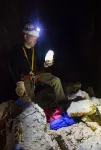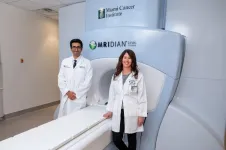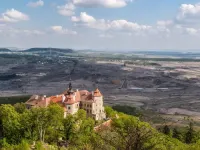(Press-News.org) The Grand Canyon’s valleys and millions of years of rock layers spanning Earth’s history have earned it a designation as one of the Seven Natural Wonders of the World. But, according to a new UNLV study, its marvels extend to vast cave systems that lie beneath the surface, which just might hold clues to better understand the future of climate change — by studying nature’s past.
A research team — led by UNLV paleoclimatologist and professor Matthew Lachniet — pulled an ancient stalagmite from the floor of an undisturbed Grand Canyon cave. By studying the mineral deposits’ geochemistry, they were able to analyze precipitation patterns during the rapidly warming period following the last Ice Age to improve understanding about the potential impact of future climate change on summer monsoon rains in the U.S. Southwest and northwestern Mexico.
Their findings, published Oct. 2 in Nature Geoscience, revealed that increasing levels of water seeped into the cave between 8,500 and 14,000 years ago, during a period known as the early Holocene when temperatures rose throughout the region. Using a paleoclimate model, the researchers determined that this was likely caused by intensified and expanded summer rainfall stemming from atmospheric impacts on air circulation patterns that more quickly melted the winter snowpacks and sped up the evaporation process that fuels monsoon rains.
This is significant, authors say, because most of the water currently infiltrating through the bedrock and into caves and aquifers — and contributing to groundwater recharge — comes from winter snowmelt. During the early Holocene, however, when peak temperatures were only slightly warmer than today, both summer and winter moisture contributed to groundwater recharge in the region.
The authors suggest that future warming, which could cause temperatures to rise above those of the early Holocene, may also lead to greater rates of summer rainfall on the high-elevation Colorado Plateau and an intensifying North American monsoon, the pattern of pronounced and increased thunderstorms and precipitation that typically occur between June and mid-September.
“What was surprising about our results is that during this past warm period, both the summer monsoon and infiltration into the cave increased, which suggests that summer was important for Grand Canyon groundwater recharge, even though today it is not an important season for recharge,” said Lachniet, who personally retrieved the stalagmite from a cave in the Redwall Formation on the South Rim of eastern Grand Canyon in 2017. “While we still expect the region to dry in the future, more intense summer rainfall may actually infiltrate into the subsurface more than it does today.”
Stalagmites are common cave formations that act as ancient rain gauges that record historic climate change. They grow as mineral-rich waters seep through the ground above and drop from the tips of stalactites on cave ceilings. Calcite minerals from tiny drops of water accumulate over thousands of years and, much like tree rings, accurately record the rainfall history of an area. Three natural forms of oxygen are found in water, and the quantity of one form decreases as rainfall increases. This information is locked into the stalagmites over time.
Because of the distinct difference in the oxygen isotope composition between summer and winter precipitation, it is possible to estimate the relative contributions from each season. Variation in uranium-234 isotope and changes in the growth thickness of stalagmite give indication of the change in the amount of precipitation.
“We were able to validate the oxygen record with the growth data, with the uranium isotope data to confirm that in fact, we see significant increases in summer moisture during this warm period, which we attribute to the monsoon,” said the University of New Mexico professor Yemane Asmerom. “Unfortunately, effective moisture is the balance between precipitation and evaporation. Unlike the more temperate Grand Canyon climate, the dry southern part, is likely to be drier, as a result of the increased temperatures."
The research team used stalagmite samples to reconstruct groundwater recharge rates — or, the amount of water that penetrates the aquifers — in the Grand Canyon area during the early years of the Holocene period. High groundwater recharge rates likely occurred on other high-elevation plateaus in the region, too, they said, though it’s unclear how the activity applies to hotter, low-elevation deserts.
What is clear is that ongoing human-caused climate change is leading to hotter temperatures throughout southwestern North America, including the Grand Canyon region. Alongside population growth and agricultural pressures, this warming can reduce the infiltration of surface water into groundwater aquifers. Groundwater recharge rates also depend on the frequency and intensity of summer rains associated with monsoon season.
Though summer infiltration isn’t a significant contributor to groundwater recharge in the region today, these latest findings suggest that could change in the future as the climate warms and monsoonal moisture increases. What’s unknown is how a projected decrease in winter precipitation and snowpack could impact overall groundwater reserves.
About the study
“Elevated Grand Canyon groundwater recharge during the warm Early Holocene” was published Oct. 2 in Nature Geoscience. In addition to Lachniet and Asmerom, the following researchers collaborated on the report: Xiaojing Du and Sylvia G. Dee of Rice University;Victor Polyak of the University of New Mexico; and Benjamin W. Tobin of the University of Kentucky.
END
Study: Scientists investigate grand canyon's ancient past to predict future climate impacts
UNLV-led team explores relationship between warming post-Ice Age temperatures and intensifying summer monsoon rains on groundwater reserves
2023-10-02
ELSE PRESS RELEASES FROM THIS DATE:
Study reveals high accuracy of MR-guided radiotherapy for intracranial itereotactic radiosurgery
2023-10-02
A new study, led by radiation oncology physicists at Miami Cancer Institute, part of Baptist Health South Florida, displayed positive results using intracranial stereotactic radiosurgery, also known as SRS, for an MR-guided radiotherapy system. The study, ‘Commissioning Intracranial Stereotactic Radiosurgery (SRS) for an MR-guided Radiotherapy (MRgRT) system: MR-RT Localization and Dosimetric End-to-End Validation’ published in the International Journal of Radiation Oncology - Biology - Physics (IJROBP), highlights positive accuracy through an end-to-end hidden target test to quantify the imaging, planning, and delivery coincidence ...
Trivalent vaccine candidate fights measles, mumps, SARS-CoV-2
2023-10-02
COLUMBUS, Ohio – Altered measles and mumps viruses could be used as a platform to create a trivalent COVID-19 vaccine that triggers immunity to multiple variant strains of the SARS-CoV-2 virus, new research in animals suggests.
The study builds upon previous studies that involved inserting a highly stable segment of the coronavirus spike protein into the measles vaccine or mumps vaccine.
In a paper publishing this week in Proceedings of the National Academy of Sciences, scientists at The Ohio State University report on a new MMS vaccine candidate – for Measles, ...
Simulations reveal the atomic-scale story of qubits
2023-10-02
Researchers led by Giulia Galli at University of Chicago’s Pritzker School of Molecular Engineering report a computational study that predicts the conditions to create specific spin defects in silicon carbide. Their findings, published online in Nature Communications, represent an important step towards identifying fabrication parameters for spin defects useful for quantum technologies.
Electronic spin defects in semiconductors and insulators are rich platforms for quantum information, sensing, and communication applications. Defects are impurities and/or misplaced atoms in a solid and the electrons associated with these atomic defects carry ...
Fair and sustainable futures beyond mining
2023-10-02
Mining brings huge social and environmental change to communities: landscapes, livelihoods and the social fabric evolve alongside the industry. But what happens when the mines close? What problems face communities that lose their main employer and the very core of their identity and social networks? A research fellow at the University of Göttingen provides recommendations for governments to successfully navigate mining communities through their transition toward non-mining economies. Based on past experiences with industrial transitions, she suggests that a three-step approach centred around stakeholder ...
Losing sleep? It might be time to check your blood pressure
2023-10-02
New study from Brigham researchers highlights a correlation between symptoms of insomnia and hypertension in women
Getting enough sleep has never been more difficult in today's fast-paced environment. Yet new research from investigators in the Channing Division of Network Medicine of Brigham and Women’s Hospital, a founding member of the Mass General Brigham healthcare system, highlights why getting a good night’s sleep is critical to staying healthy. Their research unveils that women who struggled with getting enough sleep were at greater risk of ...
Recent advances in oral health and tooth research
2023-10-02
With Halloween just around the corner, many people are pulling out plastic fangs or gnarly fake teeth to finish off their outfits. But costume prosthetics don’t replace good oral hygiene or treatments to align teeth. Below are some recent papers published in ACS journals that report insights from ancient teeth and improvements to modern dental practices. Reporters can request free access to these papers by emailing newsroom@acs.org
“Extraction Protocol for Parallel Analysis of Proteins and DNA from Ancient Teeth and Dental Calculus”
Journal of Proteome Research
Sept.12, ...
Study uncovers function of mysterious disordered regions of proteins implicated in cancer
2023-10-02
Study uncovers function of mysterious disordered regions of proteins implicated in cancer
Study Title: A disordered region controls cBAF activity via condensation and partner recruitment
Publication: Cell, Monday, October 2, 2023 (https://www.dana-farber.org/newsroom/news-releases/2023/study-uncovers-function-of-mysterious-disordered-regions-of-proteins-implicated-in-cancer/)
Dana-Farber Cancer Institute author: Cigall Kadoch, PhD
Summary:
New research from Dana-Farber Cancer Institute researcher Cigall Kadoch, PhD, along with colleagues at Princeton University and the Washington University in St. Louis, reveals a key role for intrinsically disordered ...
Liquid biopsy may help identify which patients with non-small cell lung cancer will benefit most from radiation
2023-10-02
SAN DIEGO, October 2, 2023 — A novel liquid biopsy test may help determine which patients with non-small cell lung cancer that has spread beyond the lungs are most likely to benefit from targeted, high-dose radiation, rather than drug-based therapy, a new study suggests. Findings will be presented today at the American Society for Radiation Oncology (ASTRO) Annual Meeting and published in npj Precision Oncology.
The study found that a liquid biopsy test – which identifies tumor DNA circulating ...
Pumped for frigid weather: study pinpoints cold adaptations in nervous system of Antarctic octopus
2023-10-02
By Wynne Parry
Laden with dissolved salt, Antarctic waters can hover just above freezing and even dip below it. Temperatures this low would likely kill the animals that prosper in warmer waters further north. Yet, some creatures have found ways to live in this inhospitable cold.
In a new study described in Proceedings of the National Academy of Sciences, researchers at the Marine Biological Laboratory (MBL) and their collaborators focused on how life in such a frigid habitat has altered an enzyme essential ...
Scientists identify evolutionary gateway helping pneumonia bacteria become resistant to antibiotics
2023-10-02
**Strictly embargoed until 20:00 (BST) Monday 2 October 2023**
Scientists identify evolutionary gateway helping pneumonia bacteria become resistant to antibiotics
A new study from the University of Sheffield has revealed how pneumonia cells start to become resistant to penicillin antibiotics
The effectiveness of antibiotics is increasingly under threat as the bacteria which cause pneumonia become more resistant to antibiotic treatment over time
The new research is a major step forward in helping scientists to better predict which ...
LAST 30 PRESS RELEASES:
Scientists boost cell "powerhouses" to burn more calories
Automatic label checking: The missing step in making reliable medical AI
Low daily alcohol intake linked to 50% heightened mouth cancer risk in India
American Meteorological Society announces Rick Spinrad as 2026 President-Elect
Biomass-based carbon capture spotlighted in newly released global climate webinar recording
Illuminating invisible nano pollutants: advanced bioimaging tracks the full journey of emerging nanoscale contaminants in living systems
How does age affect recovery from spinal cord injury?
Novel AI tool offers prognosis for patients with head and neck cancer
Fathers’ microplastic exposure tied to their children’s metabolic problems
Research validates laboratory model for studying high-grade serous ovarian cancer
SIR 2026 delivers transformative breakthroughs in minimally invasive medicine to improve patient care
Stem Cell Reports most downloaded papers of 2025 highlight the breadth and impact of stem cell research
Oxford-led study estimates NHS spends around 3% of its primary and secondary care budget on the health impacts of heat and cold in England
A researcher’s long quest leads to a smart composite breakthrough
Urban wild bees act as “microbial sensors” of city health.
New study finds where you live affects recovery after a hip fracture
Forecasting the impact of fully automated vehicle adoption on US road traffic injuries
Alcohol-related hospitalizations from 2016 to 2022
Semaglutide and hospitalizations in patients with obesity and established cardiovascular disease
Researchers ‘listen in’ to embryo-mother interactions during implantation using a culture system replicating the womb lining
How changing your diet could help save the world
How to make AI truly scalable and reliable for real-time traffic assignment?
Beyond fragmented markets: A new framework for efficient and stable ride-pooling
Can shape priors make road perception more reliable for autonomous driving?
AI tracks nearly 100 years of aging research, revealing key trends and gaps
Innovative techniques enable Italy’s first imaging of individual trapped atoms
KIER successfully develops Korea-made “calibration thermoelectric module” for measuring thermoelectric device performance
Diversifying US Midwest farming for stability and resilience
Emphasizing immigrants’ deservingness shifts attitudes
Japanese eels, climate change, and river temperature
[Press-News.org] Study: Scientists investigate grand canyon's ancient past to predict future climate impactsUNLV-led team explores relationship between warming post-Ice Age temperatures and intensifying summer monsoon rains on groundwater reserves







